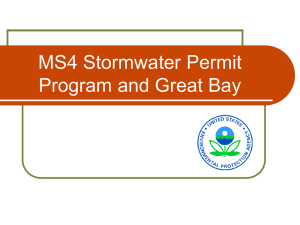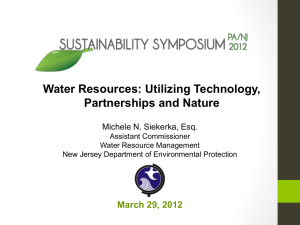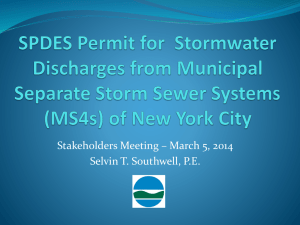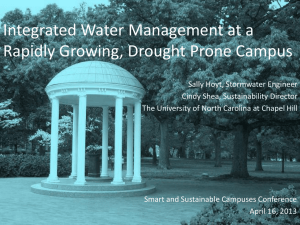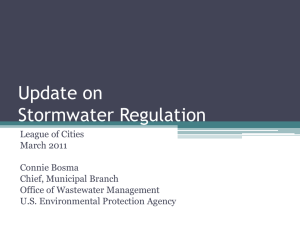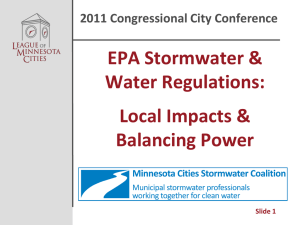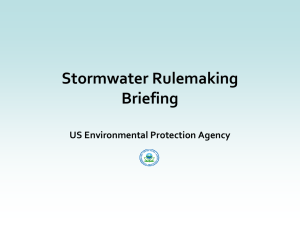Regulatory Overview - the Oklahoma Department of Environmental
advertisement
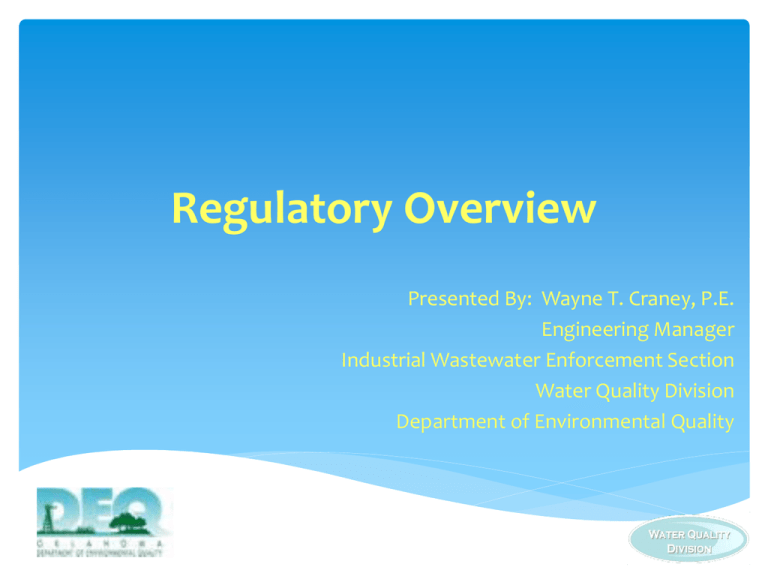
Regulatory Overview Presented By: Wayne T. Craney, P.E. Engineering Manager Industrial Wastewater Enforcement Section Water Quality Division Department of Environmental Quality Outline Regulatory History ODEQ Delegation Types of Permits in Oklahoma OKR10 History Future Regulatory Issues Regulatory History Clean Water Act Passed in 1972 Focus on point source discharges Pipes, drains, other easily identified points of discharge Established the National Pollutant Discharge Elimination System (NPDES) Amended in 1987 Addressed more diffuse sources of pollution, such as stormwater discharges Regulatory History Stormwater Regulations Phase I Promulgated in 1990 Required the following to be permitted: Medium and large municipal separate storm sewer systems (MS4s) – generally with populations ≥100,000 Construction activities disturbing ≥5 acres Industrial activities Regulatory History Stormwater Regulations Phase II Established December 8, 1999 Required the following to be permitted: Small and medium MS4s and those within urbanized area Construction activities disturbing ≥1 acre or part of a larger common plan of development Regulatory History Delegation of NPDES Programs to ODEQ November 19, 1996 Permitting and enforcement of municipal and industrial wastewater September 9, 1997 Stormwater discharges associated with construction and industrial sites Industrial pretreatment Stormwater Programs DEQ has regulatory authority over the following stormwater discharges: From MS4s From industrial activities From construction activities Through the requirements of individual permits or OKG11 (concrete batch plants) MS4s Oklahoma’s MS4 Permits Phase I (2 permittees) Individual permits City of Oklahoma City City of Tulsa Phase II (43 permittees) General permit 34 Cities 5 Counties 4 Non-Traditional Entities (e.g. Tinker AFB, OU) ODOT will be permitted when OKR04 is reauthorized Oklahoma’s Phase I MS4 Permits Individual Permits Oklahoma City first issued September 1, 1995 Tulsa first issued April 1, 1997 Both are co-permittees with ODOT and OTA Pollution Prevention Approach Stormwater Management Program (SWMP) Developed by MS4 Spells out how MS4 will address/manage stormwater discharges Oklahoma’s Phase II MS4 Permits General Permit, OKR04 Effective February 8, 2005 Pollution prevention approach Uses Stormwater Management Plan (SWMP) Must address six minimum control measures Select BMPs Identify “Measurable Goals” Evaluate effectiveness Update SWMP Industrial Stormwater Oklahoma’s Multi-Sector General Permit, OKR05 Only applies to certain industrial activities Defined by the Standard Industrial Classification (SIC) code Listed in Table 1-2 of permit by sector Only those industrial activities with SIC code in Table 1-2 need to have permit coverage Can cross-reference SIC code with NAICS code Oklahoma’s Multi-Sector General Permit, OKR05 Requirements: Stormwater pollution prevention plan (SWP3) Best management practices (BMPs) Quarterly visual monitoring Regular site inspections No Exposure Criteria requirements No permit required if facility meets these requirements Essentially all possible pollution sources are kept under cover and not exposed to precipitation Construction Stormwater EPA’s Construction Stormwater General Permit (CGP) Applies where EPA is permitting authority i.e. Indian Lands First CGP issued in 1992 Current CGP issued on February 16, 2012 Effective for 5-year period Includes new requirements to implement Effluent Limitation Guidelines and New Source Performance Standards for Construction and Development point sources – aka C&D Rule C&D Rule Requires construction site operators to meet restrictions on erosion and sediment control, pollution prevention, and stabilization Included a numeric turbidity limit for certain larger construction sites Turbidity Limit = 280 NTU Stayed by EPA on January 4, 2011 Not required to be incorporated in current construction stormwater general permits by EPA or delegated states Oklahoma’s Construction Stormwater General Permit, OKR10 Is Oklahoma’s version of EPA’s CGP Effective for 5-year period Includes non-numeric effluent limitation guidelines from C&D Rule Oklahoma’s Construction Stormwater General Permit, OKR10 Applies to construction activities that disturb an acre or greater or are part of a common plan of development that disturbs an acre or greater Requirements SWP3 Regular site inspections BMPs Buffers Oklahoma’s Construction Stormwater General Permit, OKR10 Current permit development process Reviewed EPA’s current CGP Developed draft of DEQ CGP Conducted Stakeholder Advisory Committee and DEQ Work Group meetings to discuss proposed changes Issued CGP on August 13, 2012 Effective September 13, 2012 Local Construction Permits Each MS4 has its own construction stormwater permitting requirements Required as part of MS4 program Can be more stringent than state requirements Some require permits for sites disturbing less than one acre Be sure to check with local authorities to ensure you have the appropriate permits and are meeting all local stormwater regulations Stormwater Enforcement Stormwater is the second largest category of complaints. Compliance with CWA provisions is the goal. The responsiveness of the RP determines if enforcement is necessary. If enforcement is necessary, it will be taken. Enforcement will require an administrative penalty. Enforcement Orders Inspections (14 day compliance period) Notice of Violation (NOV) Expedited Consent Order (ECO) Consent Order (CO) with Penalty/Supplemental Environmental Project (SEP) Administrative Compliance Order (ACO) with Penalty/SEP Enforcement Data FY 2010 33 NOVs issued, 9 Orders issued $72,800 in penalties/SEPs were collected FY 2011 14 NOVs issued, 7 Orders issued $34,500 in penalties/SEPs were collected FY 2012 13 NOVs issued, 4 Orders issued $30,750 in penalties/SEPs were collected Future Regulatory Issues EPA Stormwater Rulemaking Rule to be proposed by June 10, 2013 Most apply to MS4s Of general note: Exploring options for establishing specific requirements for transportation facilities; and Evaluating additional provisions specific to the Chesapeake Bay watershed Not applicable in Oklahoma Future Regulatory Issues EPA Stormwater Rulemaking Of note for construction industry: Develop performance standards from newly developed and redeveloped sites to better address stormwater management as projects are built Would require the implementation of post-construction best management practices to retain the runoff from a certain size storm event onsite Future Regulatory Issues EPA Stormwater Rulemaking Of note for MS4s: Explore options for expanding the protections of the MS4 program; Evaluate options for establishing and implementing a municipal program to reduce discharges from existing development (aka “Retrofit”); Evaluate establishing a single set of minimum measures requirements for regulated MS4s. Future Regulatory Issues Construction Effluent Limitation Guidelines Numeric Turbidity Limit Currently under review by EPA Additional treatment performance data from construction and development sites being sought Will propose limit in future May require construction site operators to sample and analyze stormwater discharges DEQ Stormwater Contacts Permitting Mark Derichsweiler – (405) 702- 8188 Karen Milford – (405) 702- 8191 Permit Administration Matt Pace - (405) 702- 6209 Amber McIntyre - (405) 702- 6167 Matt Johnson- (405) 702- 6182 Compliance/Enforcement Wayne T. Craney - (405) 702- 8139 Bob Giger (North) - (405) 702- 8112 Michele Loudenback (West)– (405) 702 - 8116 Joe Willingham (South) - (405) 702- 8129 Questions, Comments, Discussion

